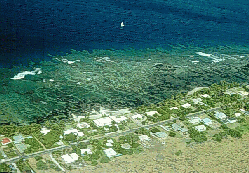Brian N. Tissot
Kalakaua Marine Education Center
University of Hawai’i at Hilo 
Introduction
Coral reefs are unique among marine communities. In addition to being spectacular displays of nature's creativity, coral reefs are reservoirs of biological diversity and are truly the "tropical rain forests of the sea." Coral reefs are also one of the most productive and diverse assemblages on Earth and are important economic resources for many tropical regions of the world, especially islands. For example, in 1991 in Hawai’i, reefs supported over $200 million in revenues from commercial, recreational and subsistence fisheries and $50 million in marine-related tourism. (Hunter, 1995). In addition, reefs buffer shorelines from waves, hurricanes and tsunamis, and generate sediments which create beaches.
However, throughout the world, reefs are being threatened with a variety of human impacts and therefore are at risk of destruction (Richmond, 1993). In order to successfully protect our reefs we must first understand their history and ecology: how they develop and what factors influence their growth and development. Accordingly, this chapter will first survey the geologic history of reefs then move on to their ecology. I will conclude by examining human impacts on reef ecosystems and steps that are being taken to more effectively manage and conserve our reefs. (more information.......>>)

